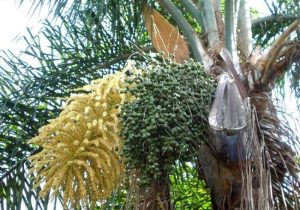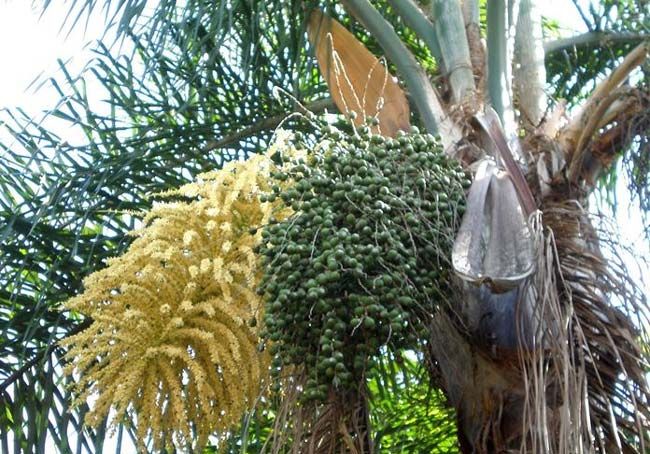Remove Seed Pods from Palm Trees
Many plants produce protective structures called seed pods or pods to enclose and distribute their seeds. Depending on the plant type, these pods come in a variety of shapes, sizes, and textures. They protect plants from environmental dangers such as dampness, pests, and physical injury, ensuring optimal conditions for germination and survival. Seed pods have a variety of opening procedures, from breaking along seams to bursting, which allows the dispersal of seeds under favorable conditions. These structures are important in seed dispersal because they use wind, animals, water, or mechanical forces to colonize new areas. Learn How to Remove Seed Pods from Palm Trees.
Should you remove seed pods from palm trees?

Pruning shears or a sharp saw
Ladder (if required)
Safety equipment (gloves and safety glasses)
Container or garbage bag for gathering seed pods
Steps to Remove Seed Pods from Palm Trees
First and foremost, put on your safety gear, including gloves to protect your hands and safety glasses to protect your eyes from falling debris.
Identify the seed pods:
Examine the palm tree to find the seed pods. These pods normally form towards the base of the fronds, also known as the crownshaft. Some palm species generate enormous clusters of seed pods, while others have them spread throughout the tree.
Choose the Right Tool:
Depending on the size and height of the seed pods, use pruning shears or a sharp saw. Pruning shears work well for smaller, approachable seed pods, whereas a saw may be required for larger or taller pods.
Ascend securely (If Necessary):
If the seed pods are high up in the tree and cannot be reached from the ground, use a sturdy ladder to reach them securely. Check that the ladder is stable and level.
Pruning or Sawing the Seed Pods:
Using your preferred instrument, carefully cut the seed pods from the tree. Make clean cuts as close to the base of the pod as possible. Take your time and exercise caution to prevent injuring the tree’s trunk or fronds.
Collect the Seed pods.
As you remove each seed pod, place it in a container or a garbage bag. This keeps the pods from dispersing on the ground and making a mess.
Dispose of the Seed Pods:
After you’ve extracted all of the seed pods, properly dispose of them. If you have a compost pile, you can compost them or put them in your yard trash bin for pickup.
After removing the seed pods, inspect the palm tree for any remaining pods or signs of disease or pests. If you spot any problems, treat them right away to keep your tree healthy.
Consider regular maintenance to avoid the buildup of seed pods in the future, especially if you have palm trees that generate seeds often. To keep your yard neat, prune or remove seed pods as needed.
How to stop queen palm from producing seed pods?
Stopping a queen palm (Syagrus romanzoffiana) from generating seeds can help maintain the tree’s look and avoid unwanted seedlings in your landscape. Queen palms are notorious for their prolific seed output; however, there are steps you can take to decrease or eliminate seed production:
Prune bloom Stalks:
Queen palms develop seeds on bloom stalks. To avoid seed generation, monitor the tree for budding flower stalks and cut them before they mature. Remove the stalks as close to the trunk as possible using pruning shears or a saw. Take care not to injure the trunk or fronds during this process.
Growth Regulators:
Some growth regulators, such as “Florel” (ethephon), can be administered to the palm to reduce flowering and seed formation. When applying growth regulators, strictly follow the manufacturer’s recommendations, as application timing and dosage are crucial.
Remove Existing Seeds:
If your queen palm has already produced seeds, remove them as soon as possible. This prevents the seeds from germinating and minimizes the possibility of additional seedlings in your landscape.
Fertilize sparingly:
Avoid over-fertilizing your queen palm, since additional nutrients might increase seed formation. Apply a balanced, slow-release palm fertilizer at the prescribed rates.
Maintain Good Care:
Make sure your queen palm gets enough water, sunlight, and nutrients. A healthy palm is less likely to produce an abundance of seeds since it focuses on growth and upkeep.
Consult a Professional: If you’re unsure about cutting flower stalks or using growth regulators, go to an arborist or gardener who specializes in palm tree maintenance. They can offer advice tailored to your individual situation.
Related Posts:
FAQS
When is the ideal time to remove palm tree seed pods?
A: Remove seed pods from palm trees when they are grown but have not yet dropped. This usually happens in the late summer or early fall. Removing them at this time avoids a mess and ensures that the seeds do not spread.
Can I remove seed pods from tall trees?
Yes, you can remove seed pods from tall trees using a ladder or extension for your pruning shear. However, exercise caution and ensure safety when working at heights.
Will removing seed pods hurt the palm tree?
A: Removing seed pods should not hurt the palm tree as long as you make clean cuts around the base of the pods. In fact, it can help the tree by shifting its energy into growth rather than seed production.
What should I do with the removed seed pods?
If you have a compost pile, you can decompose the removed seed pods. Alternatively, drop them in your yard waste bin for proper disposal.
Are there any palm tree species that do not produce seed pods?
Some palm tree species are dioecious, which means they have distinct male and female plants. Because male trees do not generate seed pods, choosing a male palm tree species can alleviate seed pod concerns.
Conclusion
Removing seed pods from palm trees is a simple but necessary maintenance chore that keeps your landscape neat and minimizes potential problems. By following the techniques given in the article, you may efficiently remove seed pods and boost the overall health and look of your palm trees.




